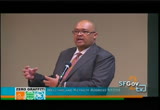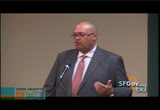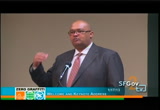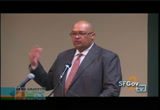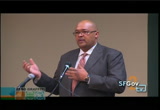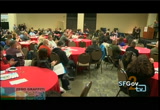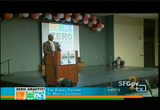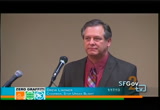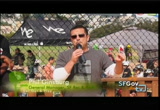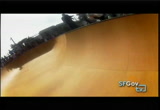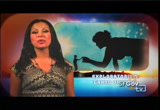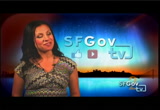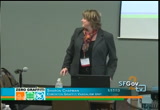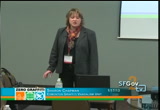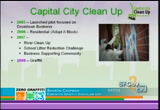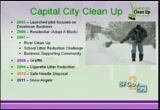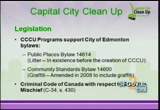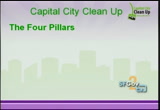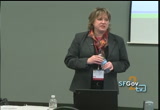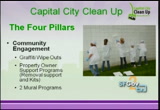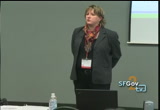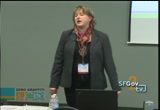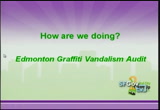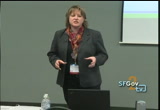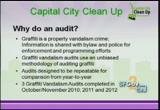tv [untitled] April 20, 2013 3:14pm-3:44pm PDT
3:14 pm
(indiscernible) -- and then we met with the property owners and matched the artists to the property owners and created murals, over 38 all around the city. putting the artists and the city on the other side (indiscernible) same solution for many of the -- (indiscernible) in the last few months we're seeing now -- murals. spending a lot of time. funding the artists program at schools. teaching that graffiti is offensive. (indiscernible)
3:15 pm
trying to teach them that san francisco is a very creative city. we want to do artwork and we'll help you; we have lots of walls around the city. we can buy your art supplies and help you. (indiscernible) the other program that we have (indiscernible) in san francisco and many other parts of the country is what we call a graffiti watch program. we provide materials, training, allow people to take ownership of certain sections of their block and help us -- problems
3:16 pm
and -- (indiscernible) that is a very successful program. we have had over 350 people who are active in that program now. facilitate a lot of programs, tackle the problem that we have. (indiscernible) i can tell you that -- a huge percentage of the -- come from san francisco. (indiscernible) some cases people come from other countries. (indiscernible) (indiscernible) our community and makes me very
3:17 pm
-- (indiscernible) someone who is debating -- (indiscernible) find a way to change the mind of people. (indiscernible) help to make that change. we heard from our supervisor david chiu, we spend more than 20 million dollars every year erasing graffiti. peoples property, huge amounts of money. (indiscernible) beautiful landscape, beautiful programs. we do have a huge -- ahead of us. i am looking forward to hearing
3:18 pm
the many ideas that will be coming out of a conference today. we have experts from law enforcement. we have experts from committed to groups. we have people from all around the country, all around the world that will be here to share many of those ideas. i know at the end of the conference everyone will leave feeling more empowered. you will learn ideas that you can go back and share in your communities. also today we will be having a press conference at around 11:30 also. and the press conference is i think one that will focus on many of the areas that we struggle. in san francisco we struggle a lot in the courthouses in terms of how to deal with vandals. sometimes in many cases they get community service. as you heard me say earlier it is the same people who are coming through 3, 4, 5 times
3:19 pm
and still doing community service. will be pushing for stiffer fines; will work closer with the judges. graffiti is a quality-of-life issue. it used to be low on the totem pole. in san francisco it is the second highest number of calls we get in terms of quality of life. the first being street cleaning issues and garbage. graffiti is now second. it is costing a lot of money. the press conference will focus on many of the types of things that we would like to see as advocates for the issue. i would like to take the opportunity to thank the -- blight for hosting the conference. please give them a big hand. (applause) our partner, san francisco beautiful,
3:20 pm
they are here with us. (applause) and of course my colleagues at the advisory board and all of you please enjoy the conference. i will be around. i will be going to many other workshops myself. i am very interested. there is a lot to share and a lot to learn. a commitment from all of you. let's keep the movement going, let's go to other cities and fight these vandals and change their mindset and keep our city beautiful. thank you very much. (applause) >>: thank you mohammed. you can understand his passion and his vision is why we are here. he is responsible for a lot of the programs that we are doing.
3:21 pm
i want to thank all of the city representatives and department that were here this morning. and also to have great support from the city family and community. these next two days should be very informative and i look forward to meeting with all of you. i encourage you to find current and former members of the graffiti advisory board. at this time could all the members that are present stand? okay. the rest will be here going over the course of a couple of days. thank you. (applause) just a little background. we've been working on this now for 8-9 months. you are far off in the distance. you think you see it but you are not sure. we had a lot of struggles, a lot of growing pains. it all came together. standing up here looking at all of you i really think that we have a good conference
3:22 pm
and you are going to enjoy it. we appreciate you all being here. the last person that i want to bring up, i need to talk a little bit about him. we met him at one of his local graffiti city greets that he does. we happened to send one of our representatives to one and share the idea of doing the international conference. he was also trying to work at the same time to do something. we decided to partner together. he is passionate about what he does. he is very dedicated. he has also been in contact with all of you over the course of six or eight months to get us to this point. drew lender (sounds like) is the chairman of the bay area nonprofit stop
3:23 pm
overblight. he shares our passion. i want to thank him for his enthusiasm to get this conference organized in at this time, drew -- (applause) >>: good morning. good morning graffiti fighters! all of you are now officially graffiti fighters, anybody who came to this organization. members of the organization are called graffiti fighters. (indiscernible) you can keep in communication after the conference and stay in touch and not let it die today. how many psychiatrist does it take to change a lightbulb? none,
3:24 pm
3:25 pm
the kids and soccer fields but we need a skate park that will keep the kids home in the neighborhood so they can play where they live. >> the children in the neighborhood and it will be a major boone. and we have generations, the youth generations that will be able to use this park in different places. >> the best park in san francisco right here. >> creating place where people can be active and lead, active, healthy life styles that are going to just stay with them for life. ♪
3:28 pm
canada. for some of you weren't in my presentation earlier today i'll go through what the city of edmonton is doing in terms of programming but then go through auditing and what we do. capital city clean up brings cities together to create safe, clean inviting xhueplts and neighborhoods. our motto is a clean and safe edmonton is a shared responsibility and we work on the premise that we can't do it alone, that we need to work as partners with the community to create solutions to graffiti vandalism and litter enforcement. just a technical point, if any of you want to ask questions, they are recording the session so they would like you to speak
3:29 pm
into the microphone and if you have any questions along the way, please feel free to ask. when did capital city clean up start? it was launched in 2005 as a pilot program focused on litter reduction in the downtown of edmonton. basically businesses were asked to adopt a block in their area and were responsible for litter clean up in that area and the program had such a huge success that they expanded the program in 2006 to include a residential component for litter pick-up. we now have over a thousand adopt a block captains that are responsible for adopting blocks around the city of edmonton for picking up litter and they each have crews of 4 to 5 thousand people so so we have four to five thousand people picking up litter. we link nonprofit
3:30 pm
organizations with businesses and the businesses pay the nonprofit organizations $650 per summer to have the nonprofits pick up litter in the blocks surrounding their business. the advantage to that is, again, community responsibility. they're not just picking up litter at the businesses, they are picking up litter in the surrounding blocks. we have a school litter reduction program that was started that year as well so we focus on educating schools on litter pick-up in the city. in 2008 the program was expanded to include graffiti and 2008 was when our by law was amended requiringing property owners it remove graffiti from their property or face a $250 crime. the one success from our program was the council at that time looked at the idea that we can't hold citizens responsible if we're not responsible ourselves, so they created our management program at that time. that
3:31 pm
includes bylaw enforcement as well as civic clean up and support for property owners. the program expanded again in 2009 to include a cigarette litter reduction program. we have a huge problem in our city with cigarette litter. we found that through our litter audits that we have done, we have a higher rate of cigarette litter in our cities compared to other cities in canada. expanded again in 2010 to include needle disposal and i said in the other session, this is what i am escaping from in edmonton right now. yay, san francisco. so we have a snow angel program where we ask citizens to voluntarily shovel the snow off their neighbor's lawns. so these are all the programs offered by the capital city clean up program. we started in 2005 as part of the waste management branch and this past year in 2012 we were
3:32 pm
moved to the community standards branch which is where we are housed now. so we have a very strong link with our programs between the programs that we offer and the community standards or community bylaw ordinances that we're operating under. the lation that we focus in on is 14614, that is the bylaw that governs litter pick up in the city. community standards 146400 is the graffiti standards bylaw. our bylaw is unique to other cities in that we don't focus on the definition of graffiti, we focus on whether or not graffiti is considered a nuisance on a property. so the bylaw is written such that it has to fall within the definition of community standards, the nuisance property and therefore we're not ever restricted by a
3:33 pm
definition and people arguing whether what's on there fits within a specific definition of graffiti, it all falls within whether what is on the building constitutes a nuisance. it also gives strength to it because we don't run into the possibility if somebody says that, well, i want it there because i gave permission to it, permission is not a factor, it's whether or not it's a nuisance property. in canada some jurisdictions have their bylaws such that they can charge taggers with fines for doing graffiti tagging. we don't have any such ordinance in our city. graffiti is managed on the enforcement side as a crime under the criminal code of canada. so just quickly i won't go through all of our programs, i did an hour and a half so i could talk forever on our programs. but basically we have our programs for our city are divided into 4 areas.
3:34 pm
civic operations, we have two graffiti removal vans that clean graffiti on our civic property alone. we do enhanced clean up, we have a contractor that does some additional clean up on city property as well as the clean up that's done by operational departments in the city. and interdepartment coordination is key. we have an operations department, operations committee that's made up of representatives from all the operations areas in the city and through that we coordinate all of our clean up on city infrastructure and we have all of our complaints come in through 311, which is the recording for the city of edmonton for all -- any complaint, recreation sign up, anything comes through 311. but we do manage our calls through that service.
3:35 pm
we have 4 seasonal bylaw officers that are dedicated to graffiti enforcement. this is -- yeah? >> how many people live in edmonton? >> there's about a million people in edmonton there's about a million. we have 4 seasonal officers that work only on graffiti. cost sharing of information of our programs is critical. our bylaw complaints, all the information that's gathered in our bylaw system is, includes information that would be of value to police. so not only do we keep information on which properties are hit, all the tagger information in the city
3:36 pm
is also tracked through our bylaw system and whenever police are going to make any arrests they have access to our bylaw system. that information is, because it's collected by bylaw, it's prepared and enforcable in a court of law so our officers are able to increase their arrests by accessing our bylaw information. our biggest arrest last year, 167 charges were laid against one person and half of that came through our bylaw system. we offer property owner support program and kits. kits are available free of charge,
3:37 pm
they include a discount on paint from roano which is the equivalent of lowe's or home depot. property owners can access our contractor up to $500 in value to have the contractor go and remove graffiti on the property owner's property free of charge up to $500, then the property owner is responsible for the balance, but last year 97 percent of the program participants got the graffiti removed by free. what we found was by offering those two programs alone, we found not only do we have a 99.37 compliance rate on our bylaw enforcement, but negative public perception about the bylaw has gone down significantly. i used to get two calls a week of people complaining about the bylaw, i don't get any of it now because we're able to defuse it by
3:38 pm
telling them about the support programs. i've been talking all afternoon. we also offer two mural programs, one that we fund ourselves directly and one that we offer community groups $2,000 to paint murals in the community. the idea is that that program is a matching program so community groups can match up to $2,000 with any type of community effort so they can get an artist to donate the art work, you can get somebody to donate paint, their volunteer hours count against the matching, so all of that is helpful in terms of getting them going. and what we really found is that some groups will use the two thousand and spend 12,000 on doing a mural. the best one i've seen, we had a high school do two dugouts that were constantly being hit, it cost them $750 and we have no problem with the dugouts any more.
3:39 pm
public awareness, we have a very, very substantial public awareness campaign. we have media support from all of our local radio, television and print media outlets and the other presentation i did, if anyone is interested i can show you some of the clips but we have basically almost every radio station in town is producing -- and television station in town is producing video clips they are airing for us, promoting our programs, calling 311, et cetera. so it's been very beneficial. we do conferences and workshops, we hosted the tags conference in edmonton last year, we're developing school programs, we have a program designed for grade 6 students, we're looking at a restoretive program this year so we're very active in the community. so that's our program in a nutshell, 15 minutes and it doesn't really give it justice to some of the nuances but it gives you a sense of the different types of activities that we're doing.
3:40 pm
so what does that mean? we've been doing a lot, how are we doing, how is edmonton really doing? what we found when we started the program, i was thrown in, in 2008, they said come up with a graffiti program. i know nothing about graffiti, i'm a communications director and i manage projects so how am i going to come up with what we are doing. we had someone on light duty from the corporate properties department going around in neighborhoods in our business revitalization zones trying to count and tell us how much graffiti was there. well, that was all very well and good but the graffiti we could find was only, the numbers were only significant to the capabilities of the person that was finding it. it wasn't giving us any real sense of whether we were increasing in graffiti vandalism, whether it was decreasing. we had been working with mgm management on our litter audits, we had been doing
3:41 pm
capital city clean up starting in 2007 started doing litter audits where we hired mgh management -- mark is the auditor who do our litter audits and now was doing our graffiti audits. basically, we looked at what we were doing on our litter audit and said there's got to be a more scientific, for lack of a better way, or statistical way of looking at how much graffiti was in a city and how we were really doing. so what we did -- so why do an audit? graffiti is a property vandalism crime. information we share from our audits are shared with bylaw and police and affect our enforcement and programming efforts. so what we're doing is taking the information that we gather from our audits and we're changing our programming accordingly. so i am able to track what's going on in each neighborhood to determine where i need to deploy my graffiti
3:42 pm
removal van, where i need to put my wipe out program, where i need to maybe come up with a mural, where i need to work with the arts council, whether i want to or not, pardon my expression, on free walls, which i don't agree with. but they have been very helpful in us really monitoring and having some proof at city effectiveness because somebody asked me in the other presentation, you've got all these programs, you've got clean up programs, how much are you spending on your program? we're spending a million dollars a year and everybody is saying, well, you know, how do you justify where you are putting those dollars? and i'm justifying putting those dollars because i can take my graffiti audit and say i know that this is where the graffiti is happeninging in the city. this is where the taggers are moving around and that information is then also shared with the edmonton police service and they are using that information in terms of going after which taggers so it's critical for a city to really
3:43 pm
look at not just anecdotally look at whether your graffiti is going up or down, it has to do with how effective you can make your programming. the graffiti audit program we have come up with, we looked everywhere to see if there was anybody doing any type of statistical analysis on graffiti vandalism in cities and we weren't able to find any so the model you will see is we worked with mark mckinney and management and worked as a team to see how we could view how graffiti affects the city. these audits are designed to be repeatable from year to year. we have done 3 audits to date and we have been able to effectively determine how we are doing. so what's the methodology? i don't know if you can see that map very well. that map is a map of the city of edmonton. all of the purple areas and the dark purple ars
53 Views
IN COLLECTIONS
SFGTV2: San Francisco Government Television Television Archive
Television Archive  Television Archive News Search Service
Television Archive News Search Service 
Uploaded by TV Archive on

 Live Music Archive
Live Music Archive Librivox Free Audio
Librivox Free Audio Metropolitan Museum
Metropolitan Museum Cleveland Museum of Art
Cleveland Museum of Art Internet Arcade
Internet Arcade Console Living Room
Console Living Room Books to Borrow
Books to Borrow Open Library
Open Library TV News
TV News Understanding 9/11
Understanding 9/11